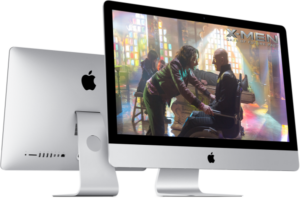It has been revealed that Apple has killed off the ability to use its iMacs as external displays for other computers, with the latest models (Retina Now on All Large iMacs).
Apple introduced Target Display mode in 2009, with its 27″ iMac. Apple Macbook owners were able to connect their computers to the iMac using a Mini DisplayPort cable, and later Thunderbolt. The iMac continued to run as a standalone computer in the background, and users could toggle between Macbook and iMac using the keyboard.
Apple has recently updated the support page for its Target Display mode, clearly stating that ‘iMac (Retina 5K, 27-inch, Late 2014) and later iMac models can’t be used as Target Display Mode displays’. This includes the company’s first 5k iMac, introduced last year. The non-support on the 2014 iMac had been thought to be a temporary measure while Apple perfected the technology – plus, of course, the company was selling a non-5k iMac that could be used with Target Display mode. However, even the 1920 x 1080 2015 models will not support use as an external display.
iFixit performed a teardown of Apple’s new 21.5″ iMac recently, which revealed the source of the 4096 x 2304 panel. As well as that, Apple has updated its webpage with information on how the high DCI-P3 colour gamut coverage was achieved.
At the beginning of the teardown, iFixit reveals an LG Display panel is used in the iMac. As well as this, there is a Texas Instruments programmable LCD Bias and synchronous step-down SWIFT converter and a Parade Technologies TCON.
According to Apple’s website, the source of the 99% DCI-P3 gamut coverage is ‘red-green phosphor LEDs’. We believe this to mean red and green phosphors over a blue LED backlight, much like Vizio’s new TVs (Vizio UHD-TVs with Dolby Vision and QD Film now Available for Order).
Analyst Comment
Apple’s continued use of Thunderbolt 2, rather than Thunderbolt 3 (which is supported by the new Skylake processors) is the most likely culprit behind the decision; the maximum supported resolution for a single Thunderbolt 2 cable is 4096 x 2160 – and that’s only at 30Hz. Dual Thunderbolt 2 cables would be required, and Apple’s Macbooks only have a single Thunderbolt output. (TA)

